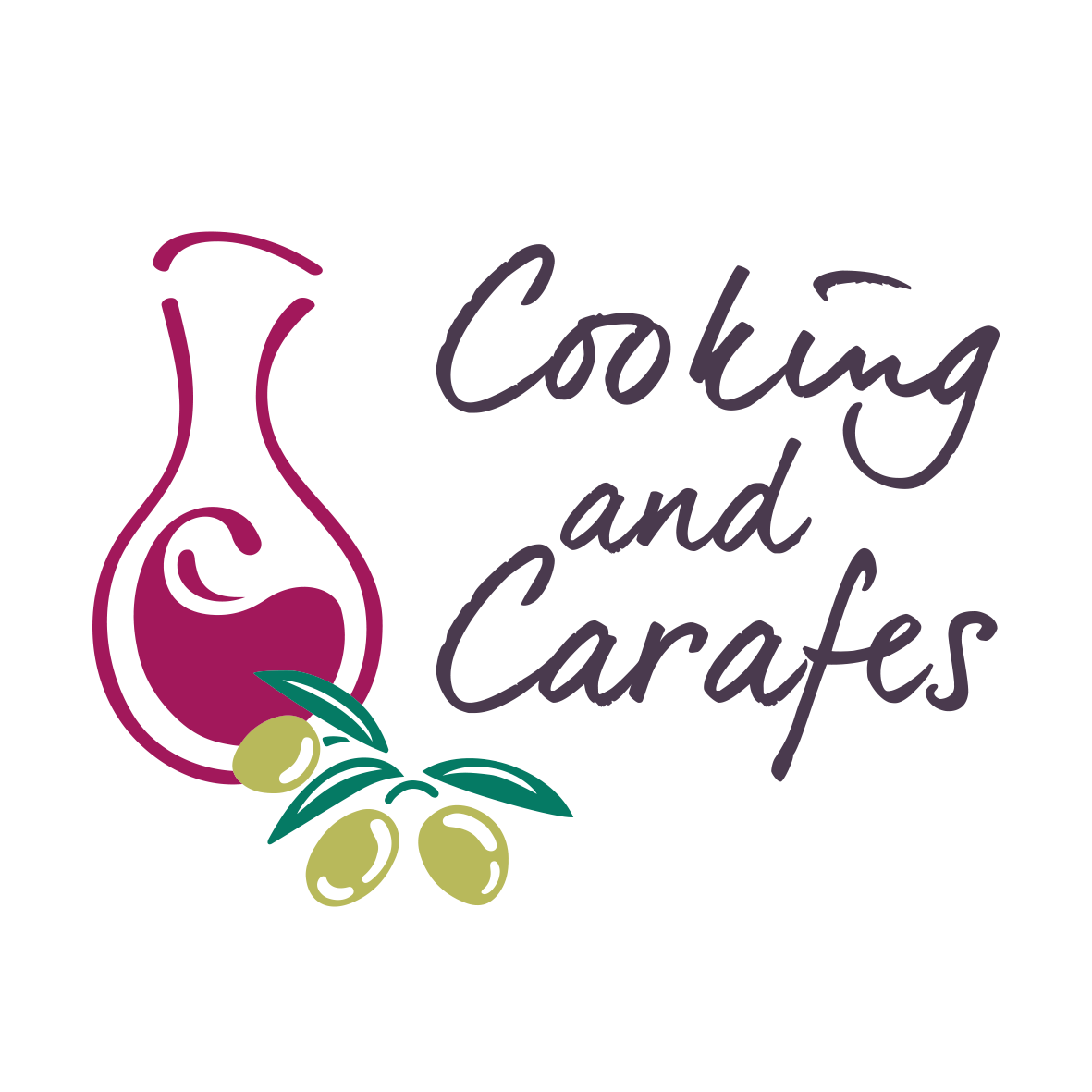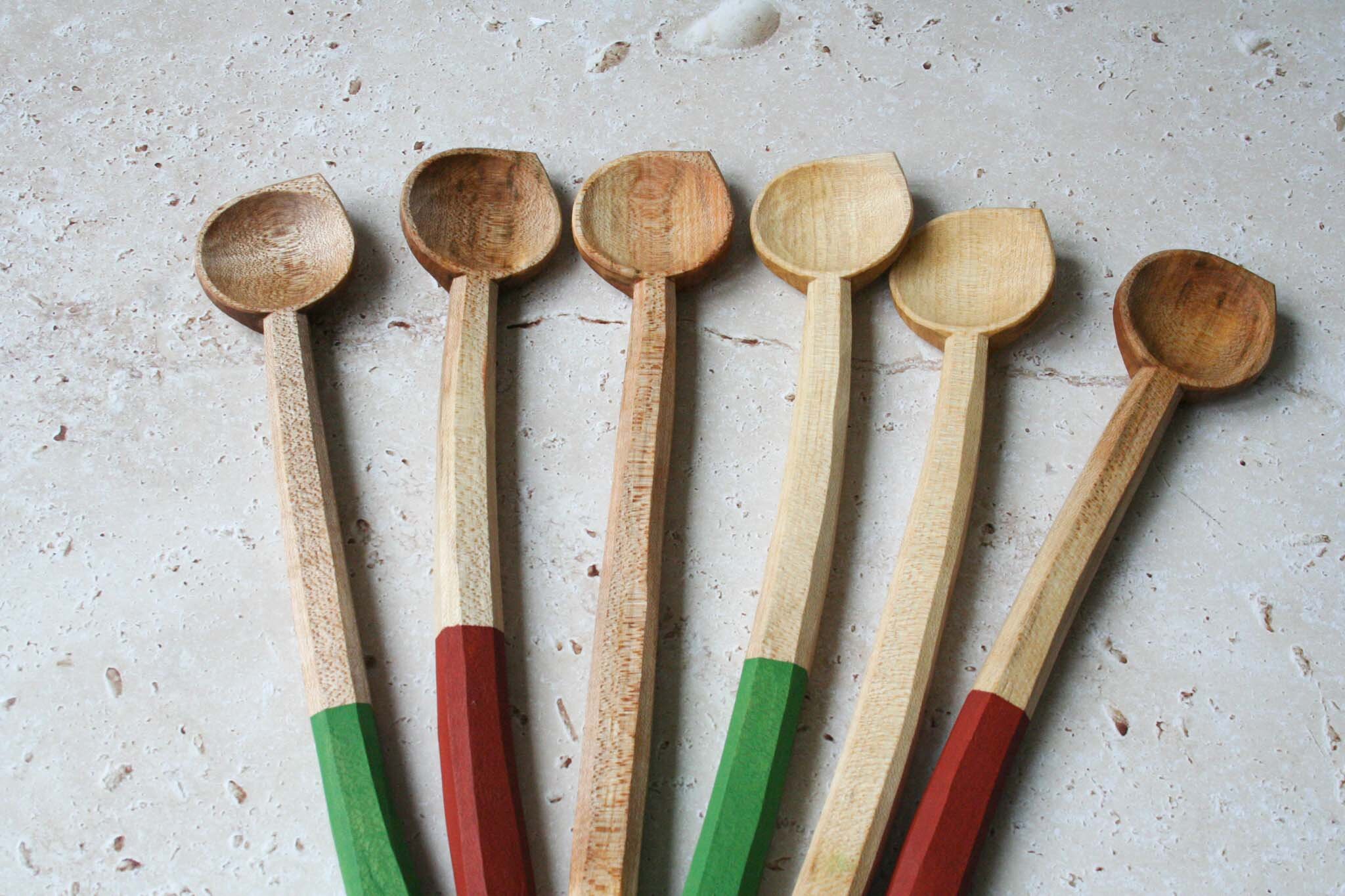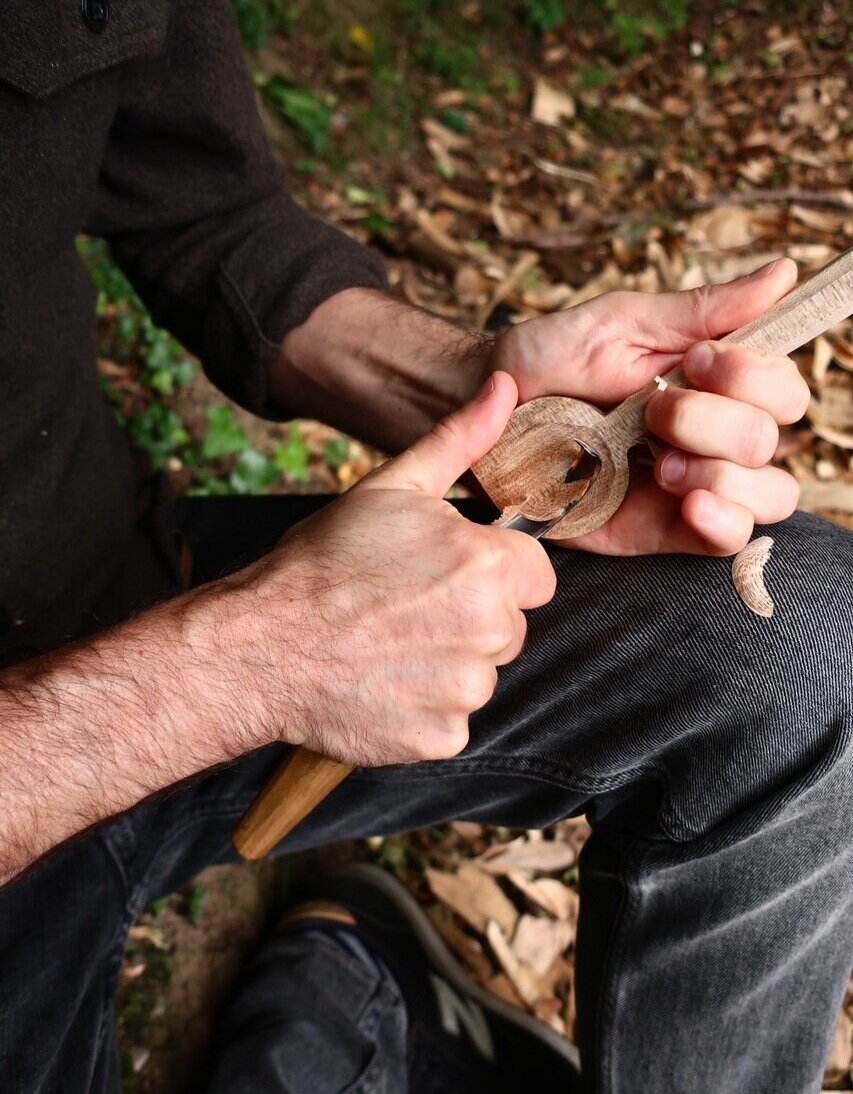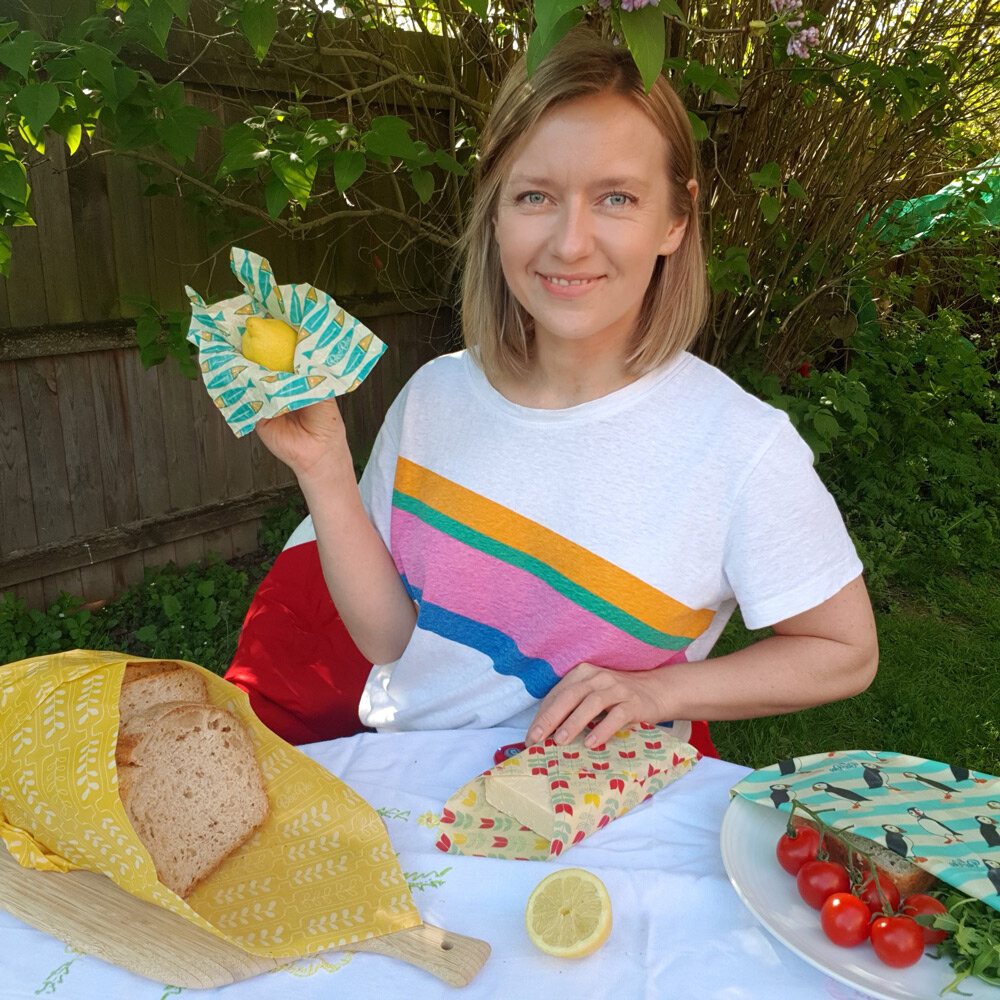Unique hand carved spoons by Will
Find out how Will makes the hand carved spoons that are available in the Cooking & Carafes Shop, and what makes them unique.
One of the items I really wanted to add to the Cooking & Carafes Shop was a beautiful cooking spoon. I always use wooden cooking spoons at home, I don’t know why but I prefer using these to other utensils we have. Of course you can easily buy one of these from a homeware store but the spoons in the shop are special, read on to find out what makes each one unique and how they are hand carved.
Who makes the spoons?
Will Priestley hand carves everyone, he carves the spoons down in Glastonbury, Somerset.
Will’s been making spoons for over six years and refers to himself as a ‘green woodworker’ because he works with fresh wood, rather than dried or seasoned. Will says about the process “It’s very much about using the natural properties of the wood (like natural bends, grain structure, flexibility etc.) to dictate the final product. As such, no two end results are exactly the same.” He always uses sustainable wood sourced from local conservation projects and uses a variety of woods.
Will began spoon carving as a hobby encouraged through his work with a conservation charity where he led volunteer groups on practical tasks like coppicing, hedge-laying and scrub clearance.
He explains “Fast forward to today and the hobby has replaced the work! I still get all of my wood from local conservation projects, foraging my own wood and knowing exactly where it came from and the reason the trees were felled is very important to me. I only carve hardwoods that are native to Britain, my favourites being cherry, sycamore, alder and birch but I’ll give anything go, really!
Aside from the chainsaw that felled the tree, there are no power tools in my process. I saw the wood to size by hand, split and rough shape it with an axe and finish with knives. By keeping my tools extremely sharp, I can leave a beautifully smooth finish on the wood. I like to think of the faceted tools marks as a lasting link between the spoon and its maker so, for this reason, I never use sand paper.”
Like myself with pasta making, Will finds his hobby, and now his work extremely therapeutic and sees it as a relaxing and meditative practice. He says “It’s a wonderful way to take your mind off the stresses of every day life, to connect with nature and see a project through every step of the way, from tree to spoon, in a way that most other crafts cannot. In the same way the food tastes better when you have grown the food yourself, eating or cooking with your own handmade spoons makes any meal that bit more enjoyable!”
Will talks through the process and how he carves each spoon
I start by splitting the wood using an axe and a big whacker (technical term).
Still with the axe, I roughly shape the spoon. The closer I can get to the final shape, the less knife work I’ll have to do.
I use a carving knife to refine the shape. It’s very easy to be complacent and cut yourself so by learning safe techniques and making them habit, accidents become very few and far between.
I hollow the bowl of the spoon using a knife with a curved blade
Lastly, is to soften some of the edges with the carving knife. These cuts are important as they make the spoon more comfortable to use and more durable.
Carefully softening the shape with a carving knife
I let the spoon dry for a few days before I paint the handle or leave it au natural. I use milk paint to decorate my work; it’s a mix of milk protein, lime powder and natural pigment that just needs water. Once the paint is dry, I treat the spoon with pure linseed oil. This helps to waterproof the spoon and bring the colour of the wood out really nicely. After a few more days to let the oil dry (sunlight really helps speed this up), the spoon is ready to be sent out in to the world…
And into your kitchen!
Each spoon has a pointed edge so you can get right round the edges of the pan, this makes it great for things like risottos and tomato sauces. It also means spoons can be right or left handed. I use a left handed one. Please make sure you choose the correct one when ordering, if it isn’t available please email kate@cookingandcarafes.co.uk to be added to a pre-order.
Shop now
Have you made the switch to Beeswax Wraps yet?
Find out more about BeeBee Wraps, why I stock them in my shop and why they are a sustainable alternative to cling film.
Long before I even contemplated selling items in the Cooking & Carafes Shop I was using Beeswax wraps, in particular BeeBee Wraps.
Selection of BeeBee Beeswax Wraps
I count myself as an advocate for reducing food waste and also making small, sustainable choices where possible to live a greener life. Beeswax wraps were starting to come to market and these seemed like an easy swap in my kitchen. Rather than using cling film for everything I could use these reusable wraps to cover food, make it last longer and use them again and again. I discovered BeeBee, helped by the fact that were made by a small business owner relatively local to me in Cambridge, I ordered myself a mixed pack online.
I loved the designs and bright colours and it wasn’t long before I also ordered myself a bread wrap for keeping my homemade focaccia fresh.
What are the benefits of BeeBee Wraps?
The 3 B’s of BeeBee & Leaf sum up why beeswax wraps are such a great, sustainable choice over cling film.
They are a back to nature product - returns to earth leaving no trace. This is because they are biodegradable add them to your compost
Better than plastic - keeps food fresher than plastic
Beautiful not boring – BeeBee don’t think the eco-alternative should be a compromise
Why I love working with BeeBee
Kath Austin, Founder of BeeBee & Leaf
Kath, the founder and I share very similar values, not only does she have a passion for positive social and environmental impact she loves good food. She believes food should be fresh, as local as possible and uncomplicated – now there’s a woman after my own heart!
The team at BeeBee share one goal; to reduce plastic pollution. Together they have saved over 17million pieces of polluting plastic hitting our natural world.
The wraps are made with organic cotton and British Beeswax and I love the range of designs that decorate them, so not only do they reduce the use of annoying cling film, they make your fridge look pretty too!
What can you use BeeBee & Leaf Wraps for?
Large BeeBee wraps or Bread BeeBee wraps are perfect for keeping bread fresh
BeeBee & Leaf Wraps are great for so many things, they make food last for longer and help reduce food waste which is something I am always encouraging.
I use beeswax wraps for:
🧀 Wrapping cheese
🥗 Covering leftovers and salads
🥬 Keeping greens and herbs fresh
🍝 Resting pasta dough
🍞 Covering dough to prove
🥪 Wrapping sandwiches / wraps / keeping bread fresh
Once I discovered that they are perfect for wrapping and leaving pasta dough to rest I introduced them to my workshops. I noticed people knew about beeswax wraps but hadn’t seen them and felt how tactile they are or what a great alternative to cling film they make.
BeeBee Wraps quickly became one of the first products I started to retail at the end of workshops and they remain a gorgeous addition to my online shop today.
Why you should make this small sustainable change
More than 1.2 billion metres, equating to 745,000 miles of cling film is used by households across Britain every year – enough to go around the circumference of the world 30 times over!
Did you know cling film is a single use plastic? It takes several years to break down and causes damaging effects to our environment in the way it is produced.
Cling film is made by melting nurdles (tiny plastic pellets) and mixing it with additives. Nurdles' small size and the transportation, handling methods used mean millions of these pellets are spilt in factories every year and are washed straight into storm drains and out to sea.
Nurdles resemble fish eggs so are frequently eaten by marine creatures and birds with harmful consequences. The plastic remains in their stomachs and toxins enter the food chain. You can read more about the damaging effects of Cling Film on the BeeBee Blog.
Make the change today
What makes shopatseed pasta bowls so special?
Find out about how Gabby from shopatseed and I came to collaborate and more about our beautiful pasta bowls
When I first received a message from Gabrielle on Instagram I couldn’t quite believe she wanted to collaborate with me, she was offering to lend me some of her beautiful ceramics for my photos. I’d been ogling over her feed and each individual piece for a while, so you can imagine the excitement when I got her message.
Gabby designs and creates hand made ceramics in her home studio in Ashdon, Essex. She makes everything using her own glazes, and uses these to make her work stand out by allowing the underlying clay to be visible while the glazes drip and splash across them.
When we finally met in real life we realised we had a lot in common. We both loved food (obviously), we’d started our businesses at similar times and we were both looking to grow our ventures, trying to squeeze in all the necessary time between our daily lives (and we still are).
How our pasta bowls turned from concept to creation
Amongst the many beautiful pieces of Gabby’s work she leant me was a gorgeous white pasta bowl - I loved it. I wanted to plate up every pasta dish in it. The ridges set off pasta perfectly, pasta wrapped up into a nest sat perfectly in the middle, set off by the grooves around the edge of the deep bowl.
I loved it so much that Gabby gifted me the bowl, which now sits proudly in my cupboard and you’ll see plenty of shots of it on the blog and my social feeds. While we were exchanging all these items I was working on my online shop, and after a few hectic months we finally sat down to talk about both our plans and how we could work more closely together.
We wanted to create the perfect collection of pasta bowls so you could all fall in love with them as much as I did! Here’s how we went from concept to creation.
The design
We decided a version of my beloved bowl was a must, the Tuerredda. Gabby suggested we make the grooves a little shorter to make it easier to scrape up all the last bits of pasta and sauce, so that’s why you’ll find the grooves decorating the edges but not interfering with your fork as you scoop up your final mouthfuls. Although we love the depth of the Tuerredda we also knew some dishes might be better in a shallower bowl. Gabby created La Maddalena, with its lower edged rim and shallower depth it’s perfect for raviolis, risottos and filled pasta.
We know not everybody is going to choose a certain bowl for a certain dish, but we thought this was important for choosing how we made the perfect pasta bowls.
Colours
I knew I wanted a Mediterranean vibe so the bright turquoise and classic white were an obvious choice. Gabby loves the black glaze which its smooth matte finish and lovely depth of colour sometimes containing shades edging towards green and even bronze. That’s why we called this collection the Tuerredda. Named after my favourite beach in Sardinia, which sprawls along the southern coastline with its crystal clear sea, white sandy beaches and the mountainous backdrop you weave your way along to reach the beach.
La Maddalena with its blue splatters on a white glaze represent the Archipelago on the north east coast of Sardinia, a cluster of rocky islands that lie amongst the deep blue waters. The splatter effect the whole bowl brings dashes of colour which makes it perfect for setting off a dish.
Individuality
Each bowl is handmade by Gabby which means each bowl is individual in its own right, each splatter, each drip is unique to the bowl. No two bowls will be the same, which is part of the reason we love them. They’re as individual as you are.
We wanted you to be able to mix and match depending on your style, and choose the perfect combinations of bowls and colours.
Practical for every day
We know these bowls are beautiful, but we don’t want you to just put them to one side for special occasions (although I confess I still save mine for just that!). That’s why Gabby makes her ceramics so they are dishwasher safe, because let’s face it we all need to make our lives a little easier at times and as two women juggling businesses, families and day jobs between us we know the little things can make a big difference.
Find out more
La Maddalena and Tuerredda are exclusive to Cooking & Carafes and available to order on my shop, but you can see more of Gabby’s work at www.shopatseed.co.uk and on her beautiful Instagram @shopatseed





































